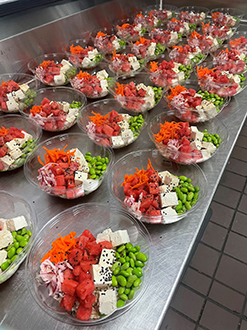A decade ago, a patient’s lunch tray at Emory University Hospital might have featured canned green beans, a salad composed of iceberg lettuce with prepackaged dressing, and a flavorless meat entrée.
Today the menu options include mushroom bourguignon with celery root mash, Southwest bean burgers with guacamole and salsa, and jackfruit tacos with pineapple salsa and cashew crema — alongside healthier takes on offerings such as beef stew and shrimp pasta salad — nutrient-dense, plant-based choices designed to nourish ill and injured patients and support their recovery.
“It doesn’t matter what your medical treatment is or what medicine they’re giving you,” says Kip Hardy, RDN, project manager in Emory’s food and nutrition department. “It’s not going to work as well in a poorly nourished body. I see our work as amplifying the work of [the entire health care team].”
Like Emory, more academic health systems — among them Northwell Health; the University of California, Davis; Boston Medical Center; Tampa General Hospital; and Intermountain Health — are reimagining their patient-care menus to complement the medical care they provide. They’re hiring award-winning chefs, sourcing seasonal produce from nearby farmers, and making nutritious and highly palatable food from scratch to feed patients, along with health professionals, family members, and support staff.
In Pennsylvania, 63 hospitals across 27 counties have joined Good Food, Healthy Hospitals. This initiative was established by the Pennsylvania Department of Health in 2014 with the goal of upgrading hospital food — from the meals on bedside trays to the snacks in hospital vending machines. (The initiative stipulates that 65% of these snacks contain less than 250 calories and be low in fat, sugar, and sodium.)
The response to hospital-menu makeovers throughout the country has been exceedingly positive. After New York City Health + Hospitals introduced plant-based meals at its 11 public hospitals in 2021, patient satisfaction soared to over 90%. Plus, per-tray food costs for the meatless meals dropped by $0.59, compared with those containing animal products, which are still available. Fittingly, the system, which serves more than 1 million patients a year, has made it a point to offer dishes from a variety of culinary traditions — dishes that range from Moroccan vegetable terrine to mushroom stroganoff.
“The really great thing that New York City did was preserve patient choice and autonomy while nudging them in the right direction,” says Anna Herby, RD, a nutrition-education specialist for the Physicians Committee for Responsible Medicine, which has studied the system’s model.
These efforts align with priorities outlined in the Make America Healthy Again Commission’s recently released strategy report. Among the planned directives is improving the food served in schools, hospitals, and to veterans, although the details haven’t been released yet.
An adjunct to treatment
The quality of hospital food is more than a punch line to well-worn jokes.
“Meals in the hospital can be quite important post-surgery,” says Dariush Mozaffarian, MD, DrPH, director of the Food is Medicine Institute at Tufts University and distinguished professor, dean emeritus, and Jean Mayer Professor at the Friedman School of Nutrition Science and Policy at Tufts. “Proper nutrition has been shown to improve wound healing, and it’s important for people who are recovering, who need more active immune systems and less inflammation.”
In fact, a 2019 study of malnourished hospital patients showed that those who received nutritionally enhanced food had 15% fewer complications and were 27% less likely to die in the hospital than those who ate regular hospital fare. Research suggests that as many as 40% of hospital patients suffer from malnutrition.
Similarly, in a 2019 meta-analysis of 27 trials, malnourished inpatients who received nutritional support had a lower mortality rate and were also less likely to be readmitted to the hospital, compared with those who didn’t.
Besides addressing the nutritional needs of patients during a hospital stay, healthy and flavorful meals are also opportunities to reinforce new ideas about food and nutrition that patients can incorporate after discharge. Indeed, argues Mozaffarian, “there’s a mental dissonance [for patients] if the food in the hospital doesn’t match the prescription that the doctors and dietitians are giving.”
“Patients benefit from just being exposed to healthy, plant-based and high-fiber foods that will help with reducing heart disease, diabetes, and cancer risk,” adds Herby. “Hospitals can take advantage of those moments.”
Here, a few of the health systems that are doing just that.
Northwell Health
When Bruno Tison, a Michelin-starred chef formerly of New York City’s famed Plaza Hotel, was recruited to reinvent the food services program at Northwell’s 28-hospital health system eight years ago, he had his work cut out for him.
Says Tison, “Patient satisfaction ratings were 9% when I started, which meant that 91% of the other health care systems in the U.S. were doing better than we were,” based on surveys from Press Ganey, which specializes in measuring the patient experience in health care.
Instead of using ultra-processed frozen and prepackaged foods that food service workers simply warmed up, the system began procuring fresh foods from local purveyors and letting chefs exercise their creativity, while emphasizing whole foods cooked in healthy ways.
“One of the first things we did was remove all fryers from the hospitals,” says Sven Gierlinger, Northwell’s chief experience officer. “We also added more fiber, used less salt and sugar, and no high-fructose corn syrup, for example.”
A unique challenge was providing pureed foods for people with swallowing difficulties. Previously all liquid nourishment was purchased and served in unappealing aseptic packaging at the bedside.
Now soft foods are made from scratch and served in attractive dishware. To make these foods more tempting, “our chefs might use chive or basil oil, or a touch of nutmeg on mashed potato,” says Tison. Such flourishes also serve the important purpose of boosting appetite, helping to solve a common problem among people who are hospitalized.
The changes required hiring new chefs for the hospitals and was implemented budget neutral. In some cases the system even saw savings. For example, the instant coffee was replaced with fresh-brewed organic coffee, saving the system $250,000 per year.
At the same time, Tison removed any clinical or medical reference on the patient menus — “anything that could remind the patient that they were in the hospital.” He notes that meals are one of the few things that patients look forward to.
The food is perceived as so good that many patients balk when they are discharged in the morning — they don’t want to miss lunch. Solution: Patients now receive a boxed meal as they’re wheeled out the door.
All the efforts have paid off: Patient satisfaction with Northwell culinary services now routinely rates in the top 10% of institutions.
This past spring the hospital made the decision to go “plant forward,” and removed beef, pork, and lamb from meal trays. Poultry, seafood, dairy, and eggs remain. The goal is to bring this same approach to its cafeteria menus.
“We’re a health care organization,” Gierlinger explains. “We need to provide healthy, delicious meals for our patients, our employees, and the communities we serve.”

The Watermelon Poke Bowl from Emory University Hospital
Credit: Emory University Hospital
Emory Healthcare
Gone are the days when “everything came out of a can or box,” says Hardy. Emory’s food and nutrition department, which provides more than 1,500 patient meals and feeds around 4,000 people in three of the hospital’s cafeterias every day, began to focus on food sustainability about 15 years ago, changing up the menu in earnest starting in about 2018.
“We knew that this mattered, that eating more whole foods and plant-based meals is good for health, but we also knew that we needed to keep people happy and not go too hard too fast,” says Hardy.
The hospital reached a turning point when physicians began requesting more plant-based food options in the cafeteria.
“That gave us permission to swing a little bigger,” according to Mike Bacha, the assistant director of culinary services at Emory University Hospital and former executive chef there.
Adapting patient meals has taken a little longer. “Dietary restrictions make recipe development much more involved,” Bacha says. Some patients need meals that are low in sodium or carbs, tasks that require more creativity, he says.
Meals for patients with heart failure who are waiting for transplants present a particular challenge. “They have sodium and fluid restrictions and are in the hospital for a long time,” says Hardy. “They get real used to the menu and want something else.”
When there was a request for soy sauce for a dish, Bacha spent days concocting different substitute versions of the salty condiment, eventually striking gold with one consisting of toasted sesame oil, molasses, and balsamic vinegar. “It worked so well, it went on to become the sauce for all our stir-fries,” Hardy says.
Emory gets much of the hospital’s food from the Common Market Southeast, a nonprofit food distributor in the greater Atlanta area that procures food from sustainable farms and from ranches in the region. The hospital supplements these supplies with food grown on a farm at Emory’s Oxford College, and a rooftop garden produces blueberries and muscadine grapes, which are native to the region.
Intermountain Health
For Alex Govern, senior director of culinary operations at Intermountain Health, which operates 34 hospitals in seven Western states, the healthy and appealing food that patients consume is a key part of their treatment, and he treats them like the VIP guests he used to serve at luxury ski resorts and fine restaurants elsewhere.
“For 99% of people who are in the hospital, it’s the worst day of their life,” Govern says. “And we have a responsibility and capability to affect the experiences of our guests in a positive way. When people eat well, they perceive the care they receive differently. They heal faster and have a better outlook.”
The food operations of the health care giant are responsible for 12.5 million meals a year, 40% of which are served to patients, while the rest are sold in cafeterias and other hospital outlets, says Robin Aufdenkampe, RDN, assistant vice president of the system’s nutrition services.
A growing proportion of that food is fresh and sourced locally. “We as a team really want to get the highest-quality, delicious food, like something from your grandma’s table, and you don’t get that when you’re buying premade product,” says Aufdenkampe.
Take the house lasagna. Previously the health system served a packaged product, but because of the excessive sodium and other undesirable components, “it left out anyone on a cardiovascular, renal, or low-sodium diet,” Aufdenkampe says. The culinary team and dietitians put their heads together to create a tasty dish that anyone can eat. The recipe now belongs in a repository of more than 8,000 recipes that chefs across the Intermountain system can access.
Such efforts have had benefits for both patients and communities. In some rural facilities under the Intermountain umbrella, the hospital’s food can be some of the best in town. A married couple in Riverton, Utah, even chose to celebrate their anniversary at the Intermountain Health Riverton Hospital café, the Wind River Grill.
Says Aufdenkampe, “It’s really good, delicious food that’s good for you.”

